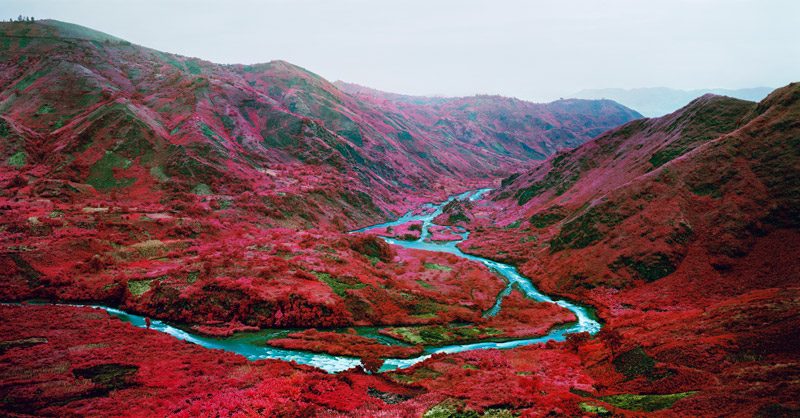DHC/ART, Montreal
October 16, 2014, to February 8, 2015>
By Zoë Tousignant
One would have to be a seasoned cynic to be indifferent to Richard Mosse’s film installation The Enclave (2012–13). Visually, it is an impressionistic, six-screened montage of beautifully lurid hues of hot pink; politically, it reveals a heretofore unseen side of the conflict that has ravaged the Democratic Republic of Congo since 1998; and theoretically, it raises fundamental questions regarding the meaning and function of images of war. This is a multi-layered, thought-provoking piece, to say the least. For me, experiencing The Enclave, which was recently on view in Montreal at DHC/ART, also brought into focus certain issues implied by the use of the documentary genre as contemporary art.
Born in Ireland in 1980, Mosse is an artist whose chosen medium of expression is documentary photography. In particular, he employs the codes and methodologies of photojournalism, and, in ways similar to French photographer Luc Delahaye and Montrealer Benoit Aquin, he creates contemporary photographic equivalents of monumental history paintings. His process is close to that of a photojournalist, in that he travels around the world to war-torn sites and spends long periods of time embedded in specific communities. Yet, according to Mosse himself, his is a “slower photojournalism” that results in images that, rather than showing the heart of the action (missiles being dropped; people being shot) reveal the enduring traces of conflict.1 He is interested in making “the impossible image,” or in revealing the emotional, social, and cultural scars that cannot be captured by traditional press photography.
Between 2010 and 2013, Mosse travelled to the Congo on eight separate occasions, each time staying for about two months. Accompanying the presentation of The Enclave at DHC/ART were three of the photographs that he made during these trips, assembled under the series title Infra. These photographs and the footage used in The Enclave were shot with Kodak Aerochrome, a recently discontinued colour film that registers infrared light and was developed in the early 1940s. Exploited extensively in aerial surveillance by the U.S. military during the Vietnam War, Kodak Aerochrome recorded the chlorophyll-filled green of living plants as bright fuchsia, creating a contrast with the unaltered, “non-living” green of camouflage clothes and installations. The 16mm film footage captured by Mosse, in collaboration with cinematographer Trevor Tweeten, follows some of the Congolese armed groups who, displaced by or formed as a result of the Rwandan genocide in the mid-1990s, inhabit the bush in the eastern Congo.
The Enclave was made to be shown in the Irish Pavilion at the 2013 Venice Biennale. It has since received much critical attention, most prominently due to its ethically questionable use of beauty – emblematized by the colour pink – to represent a site of rampant human rights violations. But this, it seems, was Mosse’s intention. In his view, beauty is a powerful tool with which to make viewers aware of the constructedness of all images of conflict.2 Immersing viewers in this quasi-monochromatic environment composed of multiple non-narrative sequences superimposed with abstract sounds, The Enclave prompts them to think about what does and doesn’t get reported by mainstream media, and what simply exceeds photographic and filmic representation.
And here the question becomes crucial of who the viewers of Mosse’s work are. The audience that frequents the Venice Biennale, DHC/ART, or any of the other institutions at which The Enclave has been and will be shown (including the Portland Art Museum; the Louisiana Museum of Modern Art; and the Jack Shainman Gallery, which represents Mosse) is arguably not one that needs much convincing about the constructedness of images of conflict.2 Although some of these institutions do attract a broader public, the installation is largely preaching to a choir who will readily agree that the documentary genre is a highly limited way of conveying information. We know this. What we don’t know is what can actually be done to change the situation, on the ground, in the Congo. On this front, The Enclave cannot provide any answers. It gives us impressions of the war, camouflaged in pink. And so we are compelled to seek information elsewhere.
2 “Richard Mosse Extended Interview,” RTÉ One YouTube channel, accessed 20 January 2015, www.youtube.com/watch?v=QbSDv-5v_x4.
Zoë Tousignant is a photography historian and independent curator specializing in Canadian photography. She holds a PhD in art history from Concordia University.


